AGATA at IKP
Customer Acceptance tests
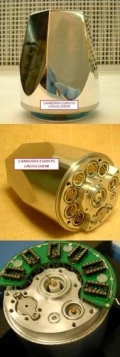
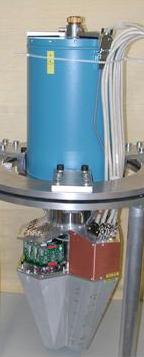
The main activity at Cologne for AGATA relates directly to the work with the detectors. On the left, you see a bare AGATA crystal. Since the surfaces are so delicate, they arrive from the company Canberra in encapsulated form to our institute (see picture 2). The encapsulation consists of a thin aluminum can and allows us to handle such crystals without clean room.
At Cologne, we test the performance of these crystals prior to acceptance. A PCB is mounted on the encapsulated crystal which allows to plug the cold part of the preamplifier in close viscinity of the crystal (see picture 3). The crystals are tested in dedicated AGATA test cryostats and their performance regarding energy resolution, efficiency and cross talk is measured. The reports on the Customer Acceptance Tests can be found in the section Acceptance Tests.
With the accepted detectors, the final AGATA triple cryostats are assembled (see picture 4). Each such cryostat contains three crystals. Extreme precision is required in mounting these crystals inside the cryostat as required by the tracking algorithms. Only 1.5mm exists between detectors. Also strict tolerances were required on the end caps, only 0.5 mm remain between endcaps in the final configuration. With these high tolerances, a total solid angle coverage of over 80% in the final configuration will be achieved.
Pulse shape analysis and characterization
Gamma ray tracking is a new concept which will be for the first time realized in a large HPGe spectrometer. It requires highly segmented detectors, such that individual interactions are mechanically separated. However the volume of these segments is still too large: tracking needs a position resolution less than 5mm to work. Therefore, digital electronics is needed to capture all 37 signals from this detector. The shape of these signals uniquely determines the position of the interaction It is than the duty of Pulse Shape analysis (PSA) to convert these traces online into position information. All coordinates of all coincident interactions are sent then further to the tracking algorithm. Its task is to identify which of these interactions belong together (improved P/T ratio) and -by using the Compton rule- to find out in which order they occurred (improved Doppler correction).
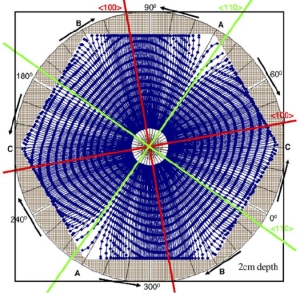
The PSA bases on a library of simulated single interactions in its comparison with experimental traces and conversion into position information. Evidently, the performance of the PSA strongly depends on the quality of the simulation. Such a simulation requires a complete understanding of the crystal properties: fields and potentials, space charge, crystal orientation, mobility of electrons and holes, electronic response functions and cross talk. Characterization aims at a full disclosure of these required parameters. Our lab is intensely involved in the development of new characterization procedures to quantify these relevant detector properties in a practical, fast, sensitive but economically way. Some achievements are shortly explained below:
A model for the electron mobility in HPGe detectors was readily available, however a mathematical description for the hole mobility in HPGe detectors was missing (2005). Such description was developed for the AGATA collaboration. To date, this the only model capable to describe the anisotropy in the hole motion. An illustration of the hole motion in a HPGe detector is shown.
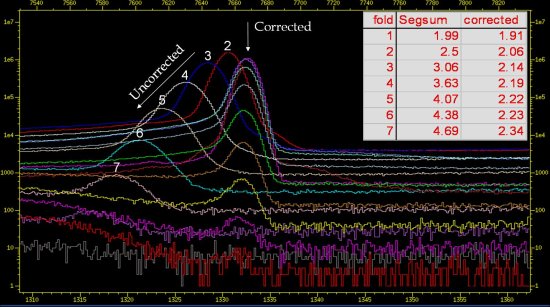 Crosstalk is a naturally occurring side effect present in any segmented (germanium) detector.
It was observed to consist of two components:
Crosstalk is a naturally occurring side effect present in any segmented (germanium) detector.
It was observed to consist of two components:
1) A fast component, which mixes with the observed transient signals. Therefore it is of importance for PSA.
2) A long component with the typical 50us decay, Which is mainly of importance for the energy resolution.
The latter creates strong energy shifts in the segment sum energy, and this proportional to the hit multiplicity
(see picture).
Methods were developed to measure such crosstalk signals,
which is not obvious because of the overlapping with the real signals.
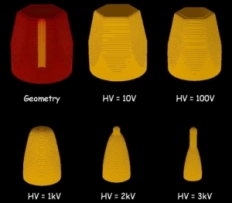 Current research was devoted to the measurement of the impurity concentration in HPGe crystals.
This impurity concentration is varying from crystal to crystal as it is on the limit that can be controlled
in the germanium production process.
This impurity concentration leads to a space charge which determines the collection field strength.
The depletion region depends on the applied voltage and on the impurity concentration (see picture).
Its extend can be monitored by measuring the capacities between core and segments.
Such measurements allow a full 3D reconstruction of the impurity concentration.
Current research was devoted to the measurement of the impurity concentration in HPGe crystals.
This impurity concentration is varying from crystal to crystal as it is on the limit that can be controlled
in the germanium production process.
This impurity concentration leads to a space charge which determines the collection field strength.
The depletion region depends on the applied voltage and on the impurity concentration (see picture).
Its extend can be monitored by measuring the capacities between core and segments.
Such measurements allow a full 3D reconstruction of the impurity concentration.
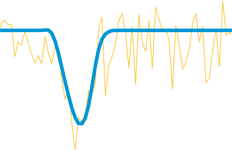
PSA requires routines that perform three major duties: simulation of traces, comparison between experimental and simulated traces and optimization of the agreement between both. A library - called ADL - was developed at IKP which allows for all this. It is hoped that this library is helpful to other people involved in Pulse Shape Analysis.
Documentation and the sources can be found at the download-section.